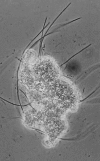Waste lipids to energy: how to optimize methane production from long-chain fatty acids (LCFA)
- PMID: 21255287
- PMCID: PMC3815362
- DOI: 10.1111/j.1751-7915.2009.00100.x
Waste lipids to energy: how to optimize methane production from long-chain fatty acids (LCFA)
Abstract
The position of high-rate anaerobic technology (HR-AnWT) in the wastewater treatment and bioenergy market can be enhanced if the range of suitable substrates is expanded. Analyzing existing technologies, applications and problems, it is clear that, until now, wastewaters with high lipids content are not effectively treated by HR-AnWT. Nevertheless, waste lipids are ideal potential substrates for biogas production, since theoretically more methane can be produced, when compared with proteins or carbohydrates. In this minireview, the classical problems of lipids methanization in anaerobic processes are discussed and new concepts to enhance lipids degradation are presented. Reactors operation, feeding strategies and prospects of technological developments for wastewater treatment are discussed. Long-chain fatty acids (LCFA) degradation is accomplished by syntrophic communities of anaerobic bacteria and methanogenic archaea. For optimal performance these syntrophic communities need to be clustered in compact aggregates, which is often difficult to achieve with wastewaters that contain fats and lipids. Driving the methane production from lipids/LCFA at industrial scale without risk of overloading and inhibition is still a challenge that has the potential for filling a gap in the existing processes and technologies for biological methane production associated to waste and wastewater treatment.
© 2009 Society for Applied Microbiology and Blackwell Publishing Ltd.
Figures


References
-
- Alves M.M. 1998.
-
- Alves M.M., Vieira J.A., Pereira R.M., Pereira M.A., Mota M. Effects of lipids and oleic acid on biomass development in anaerobic fixed‐bed reactors. Part II: oleic acid toxicity and biodegradability. Water Res. 2001;35:264–270. - PubMed
-
- Alves M.M., Picavet M.A., Pereira M.A., Cavaleiro A.J., Sousa D.Z. 2007.
-
- Angelidaki I., Ahring B.K. Effects of free long‐chain fatty acids on thermophilic anaerobic digestion. Appl Microbiol Biotechnol. 1992;37:808–812. - PubMed
-
- Angelidaki I., Ellegaard L., Ahring B.K. A comprehensive model of anaerobic bioconversion of complex substrates to biogas. Biotechnol Bioeng. 1999;63:363–372. - PubMed
Publication types
MeSH terms
Substances
LinkOut - more resources
Full Text Sources
Miscellaneous

